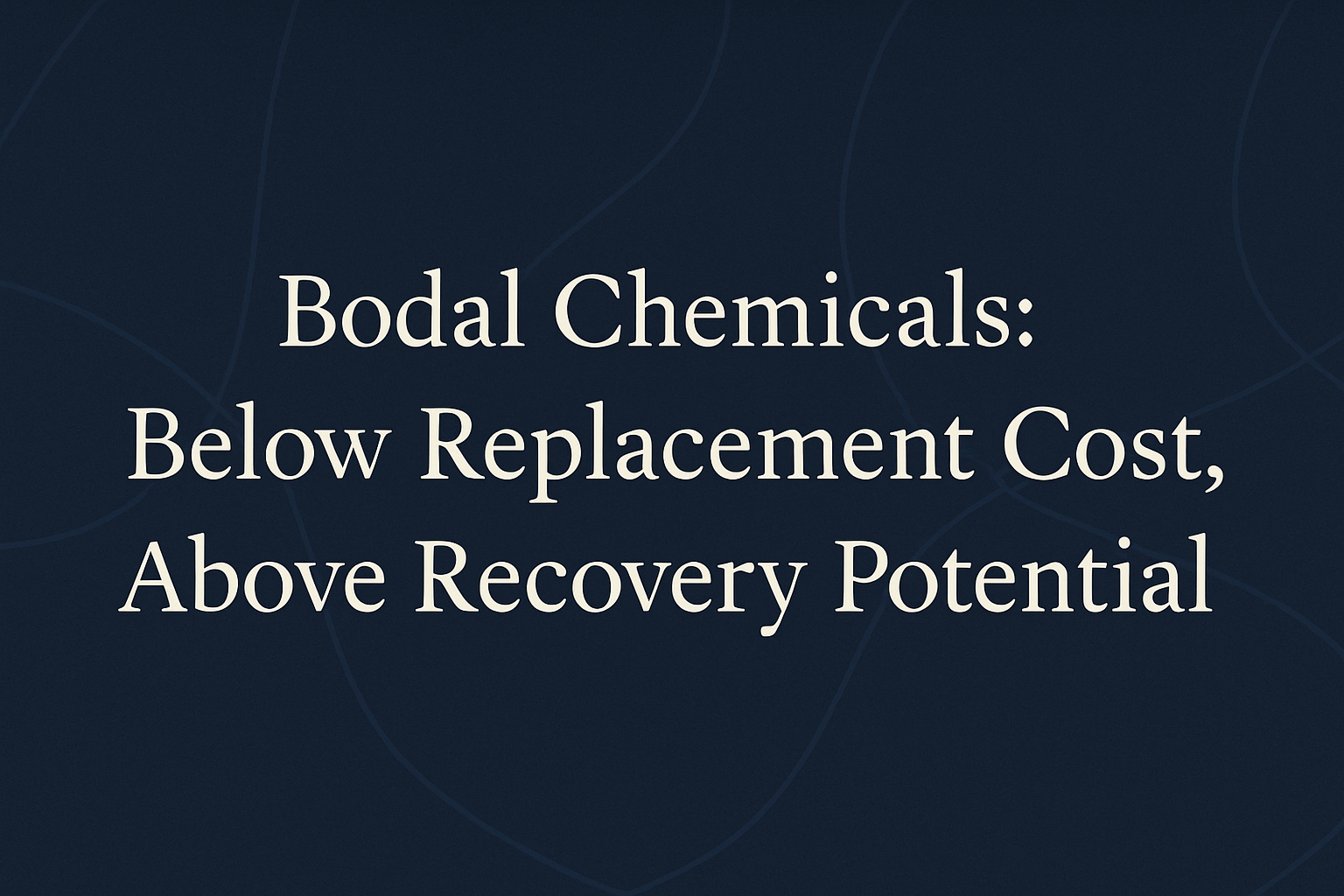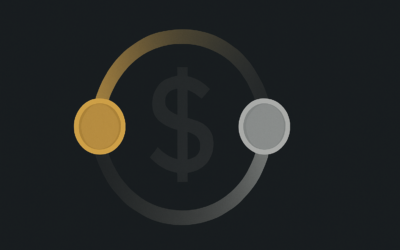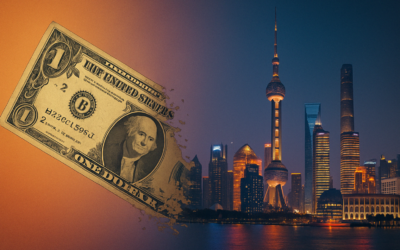Executive Summary
Bodal Chemicals Ltd. operates in the cyclical chemical sector, specializing in Dyestuffs, Dye Intermediates, and Basic Chemicals. The company has been navigating a challenging phase, marked by weak demand and fluctuating raw material prices, yet it has made significant investments in CapEx over the past few years. These investments, combined with strategic expansions, position Bodal well to capitalize on a potential upcycle in the chemical industry, where it stands to experience exponential growth in cash flows if market conditions improve.
The company’s product portfolio is concentrated in a few key segments, making it vulnerable to cyclical downturns. However, the recent completion of major projects, such as the Sakhya Project focused on specialty benzene downstream products, provides an opportunity for Bodal to diversify its revenue streams and reduce its reliance on volatile markets. The ramp-up of these new products is expected to bolster the company’s margins and improve its competitive position in the medium term.
Bodal Chemicals’ financial performance has faced pressure from weak pricing, inventory losses, and higher fixed costs in recent years. Nevertheless, the company’s significant CapEx, including its investments in modernizing production facilities, is expected to generate stable cash flows as these projects come online. The management’s decision to divest non-core assets has also strengthened the balance sheet and improved liquidity, reducing risks to solvency in the short term.
A key factor in Bodal’s future growth potential is the China+1 strategy. Currently, China and Europe together dominate the global chemical market, with a combined market share of 40-50%. However, the ongoing shift in global supply chains, driven by China’s regulatory changes and Europe’s increasing energy cost volatility, presents a unique opportunity for Indian producers like Bodal. As global companies seek alternatives to China for cost-competitive manufacturing, India’s chemical sector, supported by its cost advantages and strong compliance with environmental standards, is well-positioned to benefit. This shift towards India as a viable manufacturing hub could provide significant growth opportunities for Bodal in the long run.
Bodal Chemicals is currently trading below replacement cost, which could make it an attractive investment for those seeking exposure to the recovery of the chemical sector. While short-term profitability remains under pressure, the company’s well-positioned product portfolio, strategic investments, and potential benefits from the global supply chain shift suggest significant upside potential in the event of a market rebound. Investors should be mindful of the risks, including cyclical volatility, forex fluctuations, and regulatory challenges, but with the possibility of substantial long-term growth if the market cycle turns in favor of the industry.
Company Overview and Product Profile
Founded in 1986, Bodal Chemicals Ltd. is an established chemical manufacturer specializing in Dyestuffs, Dye Intermediates, Basic Chemicals, Chlor Alkali products, and Benzene derivatives. The company has developed a strong market presence, particularly within India’s western chemical manufacturing belt. With an integrated production model and strategic backward integration, Bodal maintains cost advantages and supply-chain security.
The company’s product portfolio includes:
- Basic Chemicals: Sulphuric Acid, Chlorosulphonic Acid, Oleum, and Thionyl Chloride, among others, primarily serving industrial end-markets.
- Dyestuffs: Reactive, Acid, Direct, and Liquid dyes, primarily used in textiles, leather, and paper industries.
- Dye Intermediates: Vinyl Sulphone, H Acid, Gamma Acid, and other intermediates, critical in dye production.
- Chlor Alkali Products: Caustic Soda, Chlorine, Hydrochloric Acid, serving a variety of industrial and pharmaceutical applications.
- Benzene Derivatives: Products such as Monochlorobenzene (MCB), Dichlorobenzene (DCB), targeting specialized pharma and agrochemical industries.
Bodal operates across seven strategically located manufacturing sites in India, supplemented by overseas subsidiaries in China, Turkey, and Indonesia, enhancing its global market access and distribution network.
Industry Overview and Demand-Supply Dynamics
The global dyes and dye intermediates industry is valued at approximately $18–21 billion, growing at around 4–6% annually. Demand is driven largely by the textiles, apparel, and consumer goods sectors, with Asia-Pacific dominating both production and consumption. China alone accounts for a significant majority, while India follows as the second-largest producer globally.
The competitive landscape is concentrated at the top. Zhejiang Longsheng, including its subsidiary DyStar, controls around 18% of the global dyestuff market, making it the largest player worldwide. Other major Chinese producers such as Zhejiang Runtu, Yabang, Transfar, and Jihua Group collectively hold a substantial share of global capacity. Outside China, Archroma, a Swiss company formed from the textile chemicals businesses of Clariant and BASF (and expanded through the acquisition of Huntsman’s textile division), commands around 12% of the global market. Sumitomo Chemical of Japan and regional players like KISCO (Korea) and Everlight Chemical (Taiwan) also hold notable positions, particularly in specialized and technical dye segments.
In comparison, India accounts for roughly 15–20% of global dyes and intermediates production. The Indian market is highly fragmented, with around 50 organized manufacturers and over 900 smaller units, mostly located in Gujarat and Maharashtra. Among organized players, Bodal Chemicals stands out as one of the largest, holding about 13% of the domestic dyestuff market and an estimated 3% share globally. Other key Indian competitors include Atul Ltd, with a diversified presence across chemicals; Kiri Industries, a significant manufacturer of H-Acid and Vinyl Sulphone; Shree Pushkar Chemicals, which is fully backward integrated but smaller in scale; and Bhageria Industries, which focuses mainly on intermediate exports.
Chinese companies dominate the global market by scale, whereas Indian companies, including Bodal, tend to compete on cost efficiency, integrated manufacturing, and proximity to growing end markets. Bodal’s backward integration — consuming around 40% of its own intermediate production — gives it an advantage in controlling costs and ensuring supply stability, a key differentiator versus many Indian peers.
The global market is undergoing structural changes. Regulatory tightening in China and rising energy costs in Europe are pushing global buyers to diversify supply chains, a shift that benefits Indian producers. While China and Europe combined account for nearly 40–50% of global market capacity, the volatility in these regions creates a long-term opportunity for cost-competitive Indian players like Bodal.
At the same time, sustainability is becoming a central theme, with increasing global demand for eco-friendly dyes and low-pollution manufacturing processes. Bodal has begun aligning with these trends through investments in effluent treatment and specialty product development, but competition from both Chinese and Western producers on this front remains intense.
In summary, Bodal Chemicals operates in a market dominated by large Chinese producers but has carved out a meaningful position in India. Its integrated model, cost advantages, and strategic exposure to supply chain shifts position it well for the future, although it must continue to navigate the cyclicality and scale-related challenges that define the industry.
Industry Cyclicality and Historical Trends
Bodal Chemicals’ core businesses — dye intermediates, dyestuffs, and basic chemicals — have historically been exposed to sharp cyclical swings, largely influenced by Chinese supply dynamics, global economic conditions, and environmental regulations.
Between 2013 and 2015, a major upcycle was triggered when China’s environmental crackdown forced widespread shutdowns of dye intermediate plants. Global supply shortages pushed prices sharply higher; H-Acid prices, for instance, surged to ₹1,500/kg in 2014. Bodal benefited significantly during this period with a strong expansion in revenues and margins. However, the cycle reversed as Chinese capacity gradually returned and global economic growth slowed. In FY2015-16, Bodal’s revenues declined and margins compressed sharply due to falling product prices and high-cost inventory write-offs.
Another favorable cycle emerged in 2017–2018 when a fresh round of pollution control measures in China again led to supply disruption. Prices for intermediates and dyes spiked, supporting strong profitability for Indian producers. Bodal saw robust earnings growth during this window as realizations remained elevated.
The most recent cycle unfolded in 2021–early 2022. Global demand rebounded sharply post-COVID, while logistical disruptions and limited Chinese supply kept product prices firm. Bodal’s key intermediates such as Vinyl Sulphone and H-Acid saw average realizations rise significantly — from around ₹160/kg to ₹259/kg for Vinyl Sulphone, and from ₹347/kg to over ₹400/kg for H-Acid — peaking around Q3 FY2022. This phase marked another strong earnings period for the company.
However, a downturn set in through 2022 and 2023. High global inflation, geopolitical uncertainty, and weak Chinese domestic demand resulted in excess Chinese production being exported aggressively at discounted prices. End-user industries across textiles and leather slowed down, and global customers engaged in destocking rather than replenishment. Consequently, Bodal’s pricing power weakened, its margins contracted sharply, and by late FY2023, EBITDA had fallen to its lowest point in five years, with quarterly profitability nearly disappearing.
Entering 2024, early signs of stabilization have emerged. Management commentary suggests that customer destocking has ended and demand has normalized at a low base. Dye intermediate volumes rebounded strongly, with revenue from this segment rising 48% year-on-year in H1 FY2025. While realizations remain below peak levels, they have shown gradual improvement, suggesting that the downcycle has likely bottomed and that Bodal may be entering the early stages of a new recovery phase.
In summary, Bodal’s earnings have historically been tightly linked to global supply disruptions, Chinese industry behavior, and broad economic trends. Current indicators point towards the company having navigated through the worst of the latest downcycle, setting the stage for potential recovery as the market environment stabilizes.
Financial Analysis and Performance
Bodal Chemicals’ financial performance over the past two decades reflects the cyclicality of its core businesses and the impact of its expansion strategy. Revenue growth has been uneven, with periods of sharp upswings during favorable cycles and contractions during downturns.
Between FY2006 and FY2015, the company expanded steadily, growing revenues from ₹150 crore to over ₹1,000 crore. Margins during this phase were modest, with EBIT margins generally in the 6–8% range, reflecting commodity-like dynamics in the chemical industry. Profitability improved sharply during upcycles, particularly in FY2014 and FY2015, supported by high dye intermediate prices.
The period from FY2016 to FY2018 marked another strong earnings phase. Revenues crossed ₹1,200 crore in FY2017, and EBIT margins improved to 16%, the highest in Bodal’s history at the time. Return on Equity (ROE) peaked at 44%, driven by both margin expansion and asset turnover improvement. The company also maintained low leverage during this period, with debt-to-equity (D/E) falling below 0.5x, reflecting strong internal cash generation.
However, financial performance weakened post-FY2018 as industry conditions softened. Revenues declined in FY2019 and FY2020, margins compressed, and cash flows moderated. Although Bodal continued expanding its capacity — particularly in chlor-alkali and benzene derivatives — these projects coincided with a global slowdown, leading to a mismatch between investment and cash generation.
The post-COVID recovery in FY2022 was visible in a sharp revenue rebound to over ₹2,000 crore. Yet margins remained below earlier peaks. EBIT margins in FY2022 stood at 8%, lower than the 14–16% levels seen during past upcycles. The improvement was short-lived; FY2023 and FY2024 saw another sharp contraction. Revenue fell to ₹1,584 crore in FY2023 and ₹1,420 crore in FY2024, while EBIT margins dropped to 3–4%. Net profits nearly disappeared in FY2024, with only ₹6 crore of PAT recorded. Return on capital employed (ROCE) fell to 3%, the lowest level since the early 2010s.
Balance sheet strength has also eroded somewhat in recent years. Net debt rose steadily, with D/E reaching 0.78x by FY2024. While manageable in absolute terms, the increase in leverage reflects cash flow stress caused by weak profitability and ongoing capital expenditure. Nevertheless, solvency risks appear limited in the near term, supported by the company’s recent efforts to monetize non-core assets and its modest near-term repayment obligations.
Asset efficiency has also declined. Net fixed asset turnover (NFAT), which was above 4x during earlier peaks, dropped to 1.5x by FY2024, reflecting underutilization of newly commissioned capacities amid a weak demand environment.
In early FY2025, there are signs of financial stabilization. Revenue growth in dye intermediates, a gradual improvement in realizations, and stabilization in working capital have helped arrest the decline. However, meaningful recovery in profitability and returns will likely hinge on a sustained market upturn and better utilization of the recently added capacities.
In summary, Bodal’s financial profile mirrors the underlying business cyclicality — strong cash generation and balance sheet health during upcycles, and pressure on margins and leverage during downcycles. The current financial position is one of subdued profitability but manageable solvency, with the potential for significant improvement if industry conditions turn favorable.
Valuation and Replacement Cost Analysis
Bodal Chemicals’ recent capital expenditure program has substantially increased its operating capacity. Management estimates the replacement cost of the company’s assets to be well over ₹2,000 crore. Against this, the current enterprise value (EV) stands around ₹1,700 crore, indicating that the business is being valued below its replacement cost.
Historically, Bodal Chemicals has delivered a normalized asset turnover of approximately 3.15x and a pre-tax ROCE of around 18% over the past decade. This compares to the current asset turnover of close to 1x and ROCE of about 5%, reflecting depressed industry conditions, low capacity utilization, and pricing pressures.
If operations revert even partially toward historical norms, the earnings potential expands meaningfully. Based on a capital employed base of ₹2,000 crore and an 18% normalized pre-tax ROCE, Bodal could generate an EBIT of roughly ₹360 crore. Assuming a typical interest and tax structure, this could translate into a normalized profit after tax (PAT) of over ₹200 crore — a significant improvement compared to the last three-year average PAT of around ₹40 crore. This translates into a normalised earnings yield of ~ 25% (PE – 4x).
Moreover, chemical industry cycles historically exhibit significant operating leverage. During upcycles, companies like Bodal often deliver peak ROCEs well above normalized levels, especially when volumes rise faster than fixed costs. Should a strong demand cycle re-emerge, there is potential for operating profits and cash flows to exceed the normalized estimates materially, providing meaningful optionality for investors. If an upcycle were to happen in the near future, we believe that the company is positioned to generate after tax cash flows of 800 – 1000 cr through the cycle, which is greater than its current market capitalisation. This asymmetry — limited further downside at current valuations and substantial upside potential if a cycle turn materializes — forms a critical part of the investment case.
In essence, Bodal Chemicals is currently priced for distress-like conditions, while the embedded operating leverage and asset base offer a pathway to much higher normalized earnings and cash flows if industry dynamics improve. The valuation relative to replacement cost provides a margin of safety, while the optionality from a possible upcycle offers an attractive risk-reward proposition.
Key Investment Risks
While Bodal Chemicals is attractively positioned from a valuation perspective, several structural and near-term risks need careful consideration.
- Cyclicality and Weak End-User Demand:
Bodal’s earnings have historically been volatile, heavily influenced by cycles in textiles, leather, and paper industries. The recent slowdown in these sectors, particularly during FY24, resulted in a sharp fall in export revenues and inventory destocking across customers. Although demand appears to have stabilized, any relapse could delay the anticipated recovery in volumes and margins. - Delay in Ramp-up of New Projects:
The company’s capex cycle, including the Saykha benzene downstream project and the Rajpura chlor-alkali expansion, has been subject to delays and cost overruns. Stabilization of these facilities is critical for improving cash flows. Further delays or lower-than-expected utilization levels would risk extending the period of depressed returns and constrain deleveraging efforts. - Elevated Leverage and Stretched Liquidity:
Following significant capex outlays, Bodal’s net leverage rose significantly. While some liquidity cushion exists through working capital headroom and non-core asset sales under consideration, the company remains dependent on improving operating cash flows to meet scheduled repayments over the next two years. Any operational underperformance would tighten liquidity further. - Competitive Pressure from China and Export Risk:
Chinese manufacturers continue to exert downward pressure on global prices, especially during periods of weak domestic demand. In FY24, Bodal’s export revenues fell sharply by 19% year-on-year, with export share dropping to 28% from 44% at its peak. Sustained aggressive Chinese exports could limit margin recovery even if volumes improve. - Regulatory and Environmental Compliance:
Compliance with environmental norms remains an ongoing operational requirement, particularly given Bodal’s exposure to effluent-intensive product segments. While investments in pollution control infrastructure have been made, further tightening of regulations could lead to incremental compliance costs or capex. - Structural Transition in Customer Preferences:
Global shifts towards sustainable and low-effluent dyes are accelerating. Bodal has initiated steps towards eco-friendly production, but global leaders in specialty chemicals have made significant progress in this domain. The company’s ability to adapt and capture evolving customer preferences will be critical to sustaining global market share over the long term.
In conclusion, while Bodal Chemicals offers a compelling value proposition relative to its replacement cost and historical earnings potential, the execution on ramp-ups, liquidity management, competitive positioning, and regulatory adaptability will determine the pace and magnitude of recovery.
Strategic Outlook and Conclusion
Bodal Chemicals has entered a phase where both risks and opportunities coexist meaningfully. While the challenges of a slow ramp-up, elevated leverage, and global competition remain real, the company’s underlying asset base and historical profitability suggest that a normalized recovery could offer substantial upside.
Valuation at current levels reflects much of the pessimism around near-term performance but leaves room for significant optionality if cash flows improve over time.
As with most cyclical investments, the outcome will ultimately depend on the company’s execution and the broader industry cycle. Investors considering Bodal today must carefully weigh these dynamics — balancing near-term uncertainties against the longer-term potential embedded in the business.
Disclaimers
This blog has been prepared by Amaltas Asset Management LLP, a SEBI-registered Portfolio Management Service (PMS) with registration number INP00009126. It is intended solely for private distribution to the recipient and should not be reproduced, redistributed, or shared without prior written consent of Amaltas Asset Management LLP. The views and information contained in this document are for informational purposes only and do not constitute investment advice or a recommendation to buy, sell, or hold any security or financial instrument. The material is based on information that is believed to be reliable but has not been independently verified. Amaltas Asset Management LLP does not represent or warrant the accuracy or completeness of any information contained herein. This document is not an offer or solicitation for investment in any product or strategy managed or advised by Amaltas Asset Management LLP. Investors are advised to consult their financial advisors before taking any investment decisions. Amaltas Asset Management LLP, its employees, and clients may have exposure to the securities mentioned in this report. The firm may also undertake transactions contrary to the views expressed herein. Past performance is not indicative of future results. All investments are subject to market risks, including possible loss of capital.
SEBI Regulatory Disclosures
- This report has been prepared in compliance with SEBI (Portfolio Managers) Regulations, 2020 and other applicable laws.
- Amaltas Asset Management LLP has not received any compensation from the companies mentioned in this report in the last 12 months.




